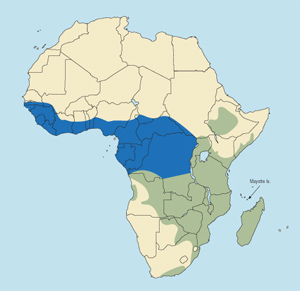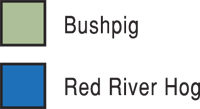 |
 |
Potamochoerus larvatus
Cerdo salvaje Africano (Sp), Buschschwein (G), Potamochère (F), Bosvark (Af).
In previous editions, the bushpig was combined with the red river hog as one species; however, Grubb has recently recognized each as a separate species, citing their morphological differences and the lack of evidence that they hybridize, and this has been generally accepted.
DESCRIPTION Shoulder height 25-32 inches (63-80 cm), sometimes more. Weight 120-250 lbs (54-114 kg), sometimes more. Bushpigs from southern Africa are largest.
The bushpig averages slightly larger than the red river hog. The long head ends in a flattened snout. The body is short and laterally flattened. The ears are long and pointed, ending in tassels. Tail is long and thin. Coat is long, shaggy and bristly, with a strong dorsal crest that begins between the ears. Coloration varies throughout the distribution range, and also with age, older animals becoming darker. Adult males in East Africa are usually black-or nearly so-with white face markings or an almost entirely white face. Some individuals are almost all white or mottled white. Young males and females are usually reddish with black facial, but sometimes are all black. Bushpigs in southern Africa are usually reddish-brown or brown, with underparts and legs darker, but some males may be all blackish or blond. Males have wart-like skin growths on the snout in front of the eyes, but they are not prominent. The tusks are small and short, with the lower tusks twice as long as the uppers. The upper tusks point downward and wear against the lower ones, creating sharp cutting edges. Females have three pairs of teats. Juveniles are dark brown with pale yellow longitudinal stripes.
BEHAVIOR Gregarious, living in family groups of 6-12, sometimes many more, led by a dominant male that guards the herd and aggressively drives off other males. Old males may be solitary. Breeding may take place year-round, but most births occur during the favorable food seasons. In southern Africa, the young are born September-April after about four months gestation, with 3-4 to a litter (the range is 1-8). Females are sexually mature at about three years. Captives have lived for 20 years.
Mainly nocturnal, resting by day in holes it digs itself in areas of dense vegetation. An omnivorous feeder, eating any and all vegetable matter, and also eggs, small birds and animals, carrion, and mineral earth. But roots and bulbs are the most important foods, and these are obtained by digging or "rooting" with the snout. Bushpigs devastate their feeding areas and are very destructive of agricultural crops, being widely hunted for this reason. Sense of smell is very good, hearing is good, eyesight is fair. A fast runner and a good swimmer. Courageous and potentially dangerous when cornered.
HABITAT Forest and thick bush. Though not a rain forest animal, it prefers moister areas, dense vegetation and soft soil. Known to range as high as 13,000 feet (4,000 m) on Mt. Kilimanjaro.
DISTRIBUTION Southeastern Sudan east of the White Nile, Ethiopia, Uganda, southern Kenya, southern Somalia, Tanzania, southern Congo (K), Zambia, Malawi, Zimbabwe, Mozambique, and parts of Angola, Botswana and South Africa. Also on Madagascar and on Mayotte Island in the Comoros, where it may have been introduced. Populations are increasing in areas when leopards have been killed off and crops planted.
TAXONOMIC NOTES Four subspecies are recognized at present: hassama (white-faced bushpig), from eastern Africa; koiropotamus (southern bushpig), from southeastern Africa and Angola; larvatus (west Malagasy bushpig), from western Madagascar and Mayotte (Comoro Islands); and hova (east Malagasy bushpig), from eastern Madagascar (however, hova may prove to be invalid). In addition somaliensis (Somali bushpig), from northeastern Kenya and Somalia, is proposed but not yet accepted. We do not separate them.
|





